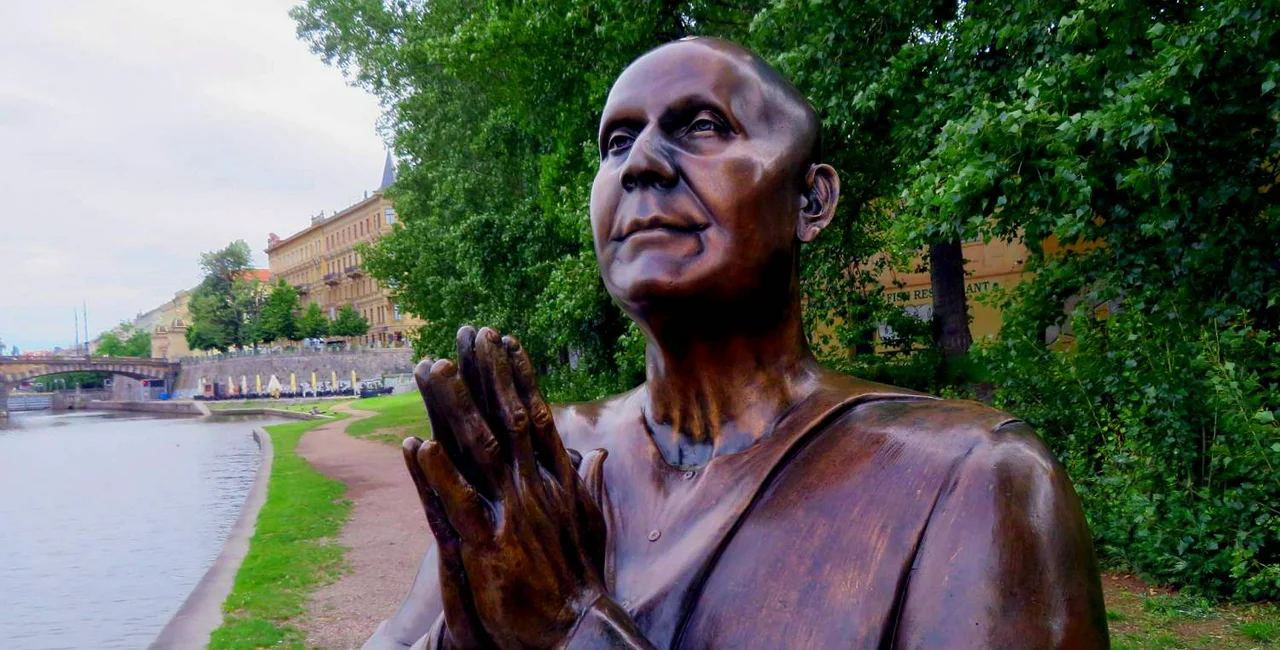Another statue will soon be removed from view in Prague, this time on Kampa island. The life-size bronze image of cult leader Sri Chinmoy has been on the embankment near Kampa Museum since 2009.
Unlike the statue of Soviet Marshal Ivan Konev, which was removed earlier this year in Prague 6, the statue of the guru Sri Chinmoy is privately owned.
Jiří Pospíšil, chairman of the board of directors of the Jan and Meda Mládek Foundation – Museum Kampa, claims that museum founder Meda Mládková was misled about the statue, which was a gift. They had been expecting a depiction of Buddha or a generic monk in prayer.
Sri Chinmoy passed away in 2007, two years before the statue was unveiled. Dozens of his former followers have come forward alleging rampant sexual abuse and strict cult conditions that run counter to the public image of man who devoted his life to world peace and healthy living.
“What matters is what the witnesses in the museum tell me. Mrs Meda [Mládková] was told it would be a Buddha statue, and with that knowledge, she signed [an agreement]. I saw the covenant, which says it was a statue of a ‘praying monk.’ There is no mention of any particular person. At the time when Mrs. Meda signed it, no one told her that she was a specific person so that she could assess a possible controversy,” Pospíšil said, according to news server Echo24.cz, which has been following the issue.

Pospíšil said he has been in contact with the Czech branch of the Sri Chinmoy Centre, as he does not want the museum to be associated with a religious cult. “When I return from vacation, we have to meet and sort it out,” Pospíšil said. “I think that if the statue embodies a certain historical figure with which certain controversies are connected, then it is not appropriate for Museum Kampa to exhibit it. I will insist on the return of the statue.”
The ceremonial unveiling of the statue in 2009 saw the participation of Olympian Dana Zátopková, then-Senator Alena Gajdušková (ČSSD) and Meda Mládková. A plaque next to the statue says in Czech and English “Statue of Harmony” and has a quote from Sri Chinmoy saying: “If you can create harmony in your life, this harmony will enter the into vast world.”
During the floods of June 2013, the head and praying hands of the statue remained above water, and various images of the statue filled newspapers as one of the enduring images of the event.

A 2014 article in the online magazine Salon outlines some of the allegations, while questioning the mainstream media’s ongoing positive coverage of the guru and his group. “All efforts were designed to feed his base egomania and hunger for fame. Even after his death, his followers continue to peddle various events, books and assorted businesses in an attempt to deify their guru, while the media continues to play along with a stunning lack of skepticism. This brilliant public relations effort has obliterated any trace of the victims,” Edwin Lyngar wrote in Salon.
Some of the earliest sexual misconduct allegations against Sri Chinmoy came in 2004, three years before his death, from the New York Post. Sri Chinmoy had been based in the Queens borough of New York City since 1964. The guru’s lawyer denied the charges and maintained the guru was celibate.
Religious scholar Tomáš Novotný from the University of Ostrava also criticizes the Sri Chinmoy, claiming he ran a cult of personality built around the manipulation of his followers.
Removing statues has become a recent trend worldwide, with statues in the US in particular coming down due to their associations with the Confederacy in the US Civil War, slavery and racism. Statues have also recently come down in the UK due to associations with slave trade.












 Reading time: 3 minutes
Reading time: 3 minutes 



























